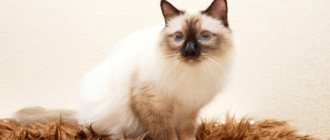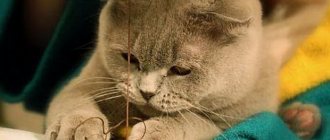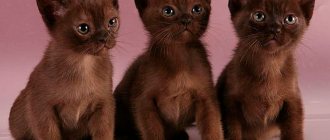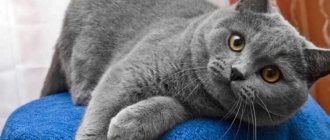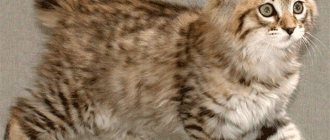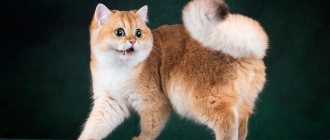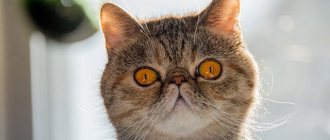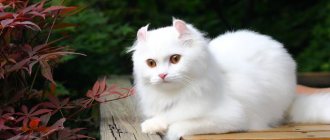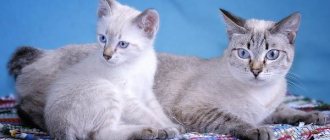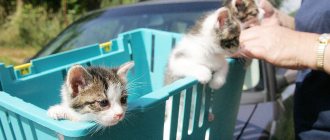The American Bobtail is a relatively large, stocky cat with a short tail and the look of a real hunter. It is considered the pride of overseas felinologists, but is not widespread outside its homeland. And since such an animal is not cheap, it is better for potential owners to familiarize themselves with the main characteristics of the breed in advance.
Brief history of the breed
American Bobtails were bred in the USA in the 60s of the last century. The official history of the breed began with a short-tailed tabby named Yodi, who was accidentally picked up by the Sanders couple on an Indian reservation in Arizona. They transported the foundling to Iowa and there he fathered offspring with a barn cat.
The short-tailed babies attracted the interest of the Sanders' neighbors, Mindy Schultz and Charlotte Bentley. One of the grown kittens was crossed with a long-haired color point cat. As a result of this mating, the first true American bobtails were born.
The breed received official recognition from TICA in 1989.
Bobtail – interesting facts
Despite the youth of the breed, many interesting things have been associated with it:
- American bobtails are considered a rarity even in their historical homeland. At the beginning of the 21st century, only 216 cats of this breed were registered there.
- According to the unofficial version, Yankee beans appeared as a result of a mutation that occurred during the breeding of ragdolls.
- It is impossible to find two cats of this breed with the same tails. Even among bobtails from the same litter, they differ in shape, length and width.
Colors
The colors of American Bobtails can be absolutely any: the breed standard does not strictly regulate the color of the breed. Mostly tabby-colored animals are found - their elegant fur coats are decorated with intricate patterns, medallions and bracelets.
Other common coat colors of these cats include:
- Chocolate (from light to almost black);
- Fiery red;
- Lilac;
- White;
- Colorpoint;
- Solid;
- Torty.
Bobtail – character and temperament
Yankee Bob is a loving, moderately active and gentle cat, equally attached to all members of the owner’s family. He loves big companies and does not tolerate loneliness.
The American Bobtail is an inventive cat with developed hunting instincts and a high level of intelligence. She is very curious and observant.
Interesting! Cats of this breed are nicknamed “Houdini in cat form.” And all because savvy and intelligent bobtails can easily open a door locked with a latch, hook or magnetic lock.
Breed and children
Yankee Beans get along well with children, especially if they don't try to hurt them. If the baby even once tries to hurt the short-tailed cat, the pet will begin to avoid communicating with him in every possible way.
Breed and other animals
Yankee Bob is a relatively peaceful cat breed. The American Bobtail gets along well with other pets, even if it is a giant St. Bernard.
True, representatives of the breed have pronounced leadership abilities and can get into fights with their relatives. But small animals arouse exclusively hunting interest among short-tailed cats. Therefore, in the house where the American Bobtail lives, there should not be small animals like guinea pigs or hamsters.
How to choose the right kitten
Pedigree kittens are sold only in specialized nurseries in North America. When choosing, it is important to make sure that the little Yankee Bob has an international veterinary passport with vaccination marks and a metric confirming his origin. You definitely need to pay attention to the conditions in which the children are kept and their appearance.
A purebred kitten must have:
- short flexible tail, without creases or large knots;
- soft, shiny and elastic wool;
- straight back;
- tassels on the ears;
- long hind limbs.
The health of a small bobtail can be judged by its soft belly, clear eyes, clean coat and lack of scratching.
Kitten care
Conscientious Yankee Bob breeders do not transfer kittens to new owners before they are 3 months old. By this age, short-tailed bobtails have time to grow a little, get stronger and become more independent.
Before taking a kitten to a new home, they buy a “dowry” for it. A small bobtail will need:
- bed or house;
- carrying bag;
- bowls for food and water;
- tray and filler;
- toys;
- hygiene products;
- scratching post
Important. At first, the small American Bobtail is fed what the breeder gave it. New foods are introduced into the diet of a short-tailed kitten gradually, making sure that they do not cause allergies or digestive disorders.
Standards
Individuals of this breed can hardly be called miniature: while females weigh on average 4-6 (rarely 7 kg), then males gain 8 or even 10 kg.
| Standard | Name |
| Head | Wedge-shaped, with rounded features, proportional to the body. The muzzle is wide, with full, round cheeks and plump whisker pads. |
| Ears | Large or medium in size, with rounded tips, a wide base and small tassels. Widely spaced. |
| Nose | Wide, large, with a noticeable depression on the bridge of the nose. |
| Torso | Rectangular, muscular, with full and strong thighs, and a wide chest. |
| Limbs | Long, slender, sinewy. The paw pads are large and elongated, and the hair often grows in tufts between the toes. |
| Tail | Short and flexible. According to the established standard, it cannot be longer than 8 cm (measured to the hock joint) and not shorter than 2 cm (this applies to adult cats, but not so strictly for kittens). The shape can be twisted at the tip, curved or straight. |
| Eyes | Almond-shaped, large, slightly sloping. The color of the iris does not always match the color of the coat (with rare exceptions). |
| Wool | The coat is hard and dense. The wool springs under your fingers. The undercoat is dense and short. In short-haired bobtails, hair grows abundantly in the belly area, in long-haired bobtails - on the tail, chest and paws. This, by the way, allows you to distinguish one species from another: long-haired ones look disheveled, shaggy and truly wild. |
The bulk of nurseries for breeding American bobtails are located in the USA, so it will not be so easy for residents of Russia to buy a kitten. And there are only a few private breeders in our country. A kitten in the “pet” category costs about $500. Exhibition animals (including those for breeding) cost even more – from $1,500.
Bobtail: care and maintenance
Yankee beans are unpretentious animals that easily adapt to new living conditions. Caring for cats of this breed comes down to proper feeding and basic hygiene.
Hygiene procedures
In order for the American Bobtail to look neat, it is provided with proper care:
- The eyes of a short-tailed cat are wiped daily with a piece of natural cloth soaked in warm boiled water.
- Yankee Bob ears are cleaned once a week. The procedure is carried out in several stages. First, a special product is instilled into the bobtail's ear. After a few minutes, gently wipe it with a cloth made of natural fabric or a cotton pad.
- The bobtail's teeth are brushed twice a week with a silicone brush and non-foaming paste. This simple procedure will help remove plaque and prevent stone formation.
Grooming
Maintaining the American Bobtail's coat in proper condition is not difficult at all:
- During the molting period, the cat is combed daily using a slicker brush or furminator. The rest of the time the procedure is carried out 2-3 times a week.
- Yankee Bob does not need frequent washing, especially if he is kept in an apartment and does not go outside. A short-tailed cat is given bath treatments no more than 3-4 times a year. Bathe the American Bobtail in a basin of warm water using a special shampoo. After washing the cat, dry it with a towel and, if necessary, dry it with a hairdryer.
On a note. The short-tailed Yankee Bob, which is afraid of water, can be cleaned with dry shampoo or a degreasing powder.
Tray
A small, cramped tray is not suitable for large and energetic American Bobtails to relieve their natural needs. These cats will be much more comfortable with a spacious toilet in the form of an enclosed house. But the type of filler does not really matter. Therefore, you can use the one to which the Yankee Bob was accustomed by the breeder.
Bobtail - feeding a cat
High-quality nutrition is the key to the proper development and health of the American Bobtail. Therefore, a short-tailed cat needs to be provided with balanced feeding.
Complete diet
The American Bobtail cat will not refuse either industrial or natural food. When choosing drying, it is advisable to give preference to super-premium or holistic-class products, which contain all the necessary nutrients.
The following foods are best suited for short-tailed Yankee beans:
- AATU;
- Carnilove;
- Now Natural Holistic;
- Acana.
On a note. A cat who eats dry food should have easy access to fresh drinking water.
The natural diet for the American Bobtail is composed so that it is dominated by lean, fresh meat. Also on the menu of a short-tailed cat must include:
- pureed vegetables;
- raw quail eggs;
- dairy products;
- lean sea fish.
On a note. The serving size is calculated so that there are 20 g of food per 1 kg of Yankee bean weight.
It is strictly forbidden to give the American Bobtail:
- fresh milk;
- vegetable proteins;
- sweets;
- onion;
- garlic.
Feeding frequency
The kitten eats less and more often than an adult American Bobtail. Therefore, the number of feedings directly depends on the age of the short-tailed pet:
- up to 8 weeks – 5-6 times a day;
- 2-5 months – 3-4 times a day;
- from 6 months – 2 times a day.
It is advisable to feed the American Bobtail at the same time so that the cat gets used to the regime.
Vitamins and minerals
When fed naturally, the American Bobtail does not receive all the necessary microelements. Therefore, vitamin and mineral supplements are introduced into the diet twice a year.
Typically a Yankee bean is given:
- AniVital FeliDerm;
- 8 in 1 Excel Brewer's Yeast;
- Nutri-Vet Probiotics Salmon Oil;
- Beaphar Laveta Super;
- Petvital Energy (Canina);
- VetExpert VetAminex.
Important! Before giving your bobtail vitamin and mineral supplements, you should consult your veterinarian.
Specialized feed
The choice of food is an important criterion for a cat’s health. Here you should also follow some rules:
You can't skimp on your pet's health. Cheap dry food can cause digestive problems, cause urolithiasis, lead to vitamin deficiency, and problems with hair and skin. Preference should be given to premium food.
It is necessary to alternate dry and wet food. For example, give dry food during the day, and offer soft food for dinner.
IMPORTANT: dry and wet food must be from the same manufacturer.
There should always be clean and fresh water in the bowl.
Bobtail: education and physical activity
American Bobtails are highly intelligent and very smart cats that quickly understand what is required of them. To prevent a short-tailed pet from developing bad habits, they begin raising it immediately after purchase. The kitten is weaned from damaging the owner's property, playing with teeth and scratching.
The little Yankee Bob is immediately trained to use the litter box and scratching post.
Cats of this breed love to be outdoors and quickly get used to a harness and leash. To maintain muscle tone and joint health, Yankee Bobs need not only walks, but also physical activity.
To stimulate their hunting skills, short-tailed cats are offered to play with string pendants, fishing rods, balls or laser pointers.
Features of behavior
The American Bobtail is considered an active breed; on the activity scale it has an 8 out of 10 points. They like to walk down the street. especially in fresh nature. This way they can fully demonstrate their hunting skills. You need to buy a lot of toys for them so that he has something to spend his time with. From time to time they need to be replaced with new or more interesting ones.
Vaccinations and antiparasitic treatments
To protect against viral diseases, the American Bobtail is regularly vaccinated with a complex drug that produces immunity:
- to calcivirus;
- panleukopenia;
- rhinotracheitis;
- leptospirosis.
A Yankee Bob kitten's first vaccination is given at 8 weeks. After 4 weeks, the vaccine is reintroduced, but with an anti-rabies component. In the future, a cat of this breed is vaccinated annually.
On a note. Yankee Beans that participate in dog shows are additionally vaccinated against chlamydia.
Before vaccination, a short-tailed cat must be treated for external and internal parasites. First, fleas are removed from the Yankee Bob using a special shampoo or drops, and after a few days the animal is given deworming tablets.
When carrying out antiparasitic treatment, the dose of the drug is calculated strictly based on the weight of the bobtail.
Bobtail: pros and cons of the breed
Like any other breed of cat, short-tailed Yankee Bobs have both advantages and disadvantages:
| pros | Minuses |
| Pleasant exterior | Tendency to diseases of the musculoskeletal system |
| Cleanliness | High cost of kittens |
| Kindness towards people and other animals | |
| Quick wits |
The American Bobtail is an outgoing and friendly cat with an exotic appearance and a developed hunting instinct.
The short tail and tufts on the ears give it a lynx-like appearance and add to its popularity. And even the reputation of an escape artist, able to get out of a locked room, does not reduce interest in the Yankee Bob.
Health
These are strong, healthy cats. True, sometimes bobtails are born without a tail, and only a small hole in the place where it should be reminds of a tail.
In English, such cats are called “rumpie”. These kittens should be avoided as they may develop back problems.
Some bobtails suffer from hip dysplasia, or congenital dislocation.
This is a hereditary disease that, although not fatal, can be very painful, especially as the cat gets older. It leads to lameness, arthrosis and deprives the joint of mobility.
